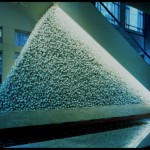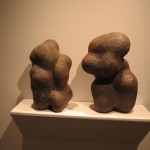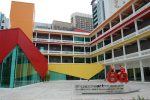Post by Mei-ling Hom and David McClelland
This is part 2 of a report from Asia. Part I, on 8Q, the new Singapore art museum, is here.

The scale of the castings is really impressive
Working in the bronze foundry near Ayuthaya, Thailand is art on an industrial scale. The energy conveyed through the noise, smell, and visual overload is only matched in our experience by the earth shaking intensity of the limestone mills in southern Indiana. But it is stimulating to be surrounded by fine artists working with a superb technical staff.

Meiling stands next to the tiny rat which will accompany a 200+ foot high Ganesha
The scale of the bronze casting is astonishing. The largest piece that the foundry is working on is a 90-foot standing Ganesha, the elephant headed god, who is destined for a temple in southern Thailand. The smallest pieces are scores of palm sized religious sculptures or kitschy elephants for the souvenir market. In between are life sized portrait sculpture, memorial plaques, and lots of artistic experiments by artists both Thai and foreign.

A polisher works on Chatchai Puipia’s self portrait
We were introduced to the foundry by Chatchai Puipia, a Thai painter who turned to bronze to realize some sculptural projects he had previously executed in less permanent materials.

Mei-ling Hom writes poetry on the wax for one of her clouds
Mei-ling Hom is casting a group of bronze clouds with various surfaces including a pair inscribed with royal poetry outlining the recipes for traveling food. We started this project last winter and have returned to check the first group of castings and complete the second group.

Chatchai Puipia’s large bronze legs
Chatchai is in the final stages of an enormous project which included a pair of crossed legs now installed in the Napa Valley, an edition of seated popes based on a self portrait, and a whole range of cheeky figures peering back through their spread legs.

Ravinder Reddy (L) and Chatchai Puipia in front of Reddy’s sculpture
Another artist working for the first time in a large scale in bronze is Ravinder Reddy, an Indian sculptor noted for his figurative fiberglass work. His large portrait is destined for a sculpture park in Thailand, but he hopes to cast a series of other portraits for potential siting in other countries.
Most artists arrive with models of the work to be cast but some sculptors have braved the heat and roar of the foundry to create their original works. The models are then enlarged either by the computer controlled triaxial milling machine which creates a styrofoam blank of approximately the final size or by a team of technicians who create a final sized model by eye. In either case the sculptor must then apply the final touches to the model in plaster or plastiline. Almost all the casting is then done by creating a wax model from the plaster/foam original.

Pouring bronze into redhot ceramic shells
The wax is coated with a ceramic shell which is heated until the wax runs out leaving a void which is in turn filled with molten bronze to create a likeness of the original. When cool, the shell is chipped away and the casting channels and flaws are ground off. If the piece is very large it may be cast in sections, which are welded together.

A sea of Ganesha images rough from the mold
The welds have to be ground flush and then the whole work is polished several times before the final patina is applied. The air is full of bronze dust and fine plaster and silica dust. The energy level of the foundry is very high and while this can be stimulating during the working day we certainly slump at quitting time. Final recovery is best effected by a cool twilight picnic in the nearby ruins of the historic capital of Ayuthaya.
–Mei-ling Hom is working on a permanent installation for the Philadelphia airport to be installed in the Fall of 2009 and David McClelland is working as the English editor of the “Leg Up Society“, a Thai arts group.








